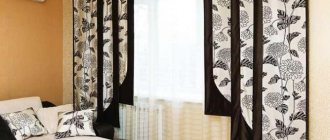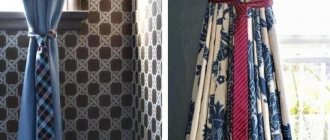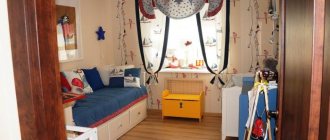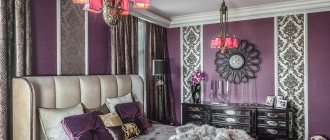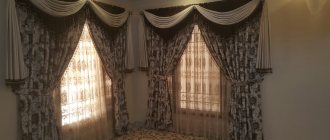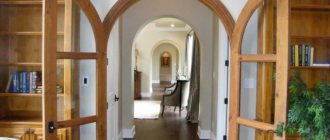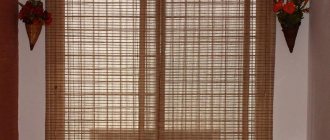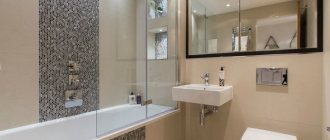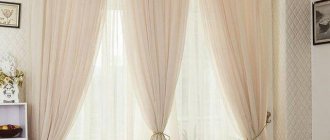What is a lambrequin: textiles in a modern interior
Lambrequin is a decorative element in the textile design of a window, which is appropriate in any modern interior. Not a single 17th-century interior could do without a lambrequin. In palaces, among the luxury of Baroque, gold and marble sculptures, a rich lambrequin did not stand out from the general background. But is it appropriate to use this decorative detail in modern apartments? Of course yes! Even decorating an apartment in a minimalist style is not a reason to refuse a lambrequin; the main thing is to fit it correctly into the interior.
Kinds
There are many types of lambrequins for the bedroom or living room. They will give your decor a completely different look. These decorative elements are used where you need to create beauty and luxury. They are used not only at home, but also in public spaces. You can have a great design, but it might be missing some flair.
The word “lambrequin” is often used in conversation and in various publishing houses. But few people have any idea what it means. What is a lambrequin? This is not just a decorative element. A lambrequin is an ingenious fabric invention that is placed in front of a curtain. It consists of frills that hide the curtain rod and the top of the tulle. Using it you can visually make the window narrower or wider.
Existing types of window decor:
- bandeau is a rigid lambrequin;
- decorative element figured, soft;
- combined lambrequin. This is a good combination of the first and second types.
Tips for using lambrequin in the kitchen
Many housewives opt for a lambrequin in the kitchen, abandoning curtains altogether. When space allows, using curtains and lambrequins together in the kitchen is also acceptable. And if you think through all the details in advance, then any window decoration will bring only joy.
The simpler and more concise the shape of the lambrequin in the kitchen, the easier it will be to care for the window as a whole.
The first thing you should take care of is the choice of fabric. For both curtains and lambrequins, textiles must have special properties.
Namely:
- Easily withstands multiple washes. Curtains in the kitchen get dirty much faster than in other rooms and require constant care.
- Easy to iron. Wrinkled curtains look untidy, and constantly ironing complex fabrics is torture for the housewife.
- Special impregnation. Modern fabrics are often impregnated with water- and dirt-repellent and fire-retardant substances. This fabric needs to be washed less often and cooking in the kitchen becomes safer. Flying sparks can cause ordinary curtains to burst into flames or melt.
- Resistance to fading in the sun. The lambrequin in the kitchen is not protected from direct sunlight by thick curtains, so it must withstand such a test.
What types of lambrequins are there (video)
Now, having understood the shapes and types of lambrequins, it’s easy to choose your own. After all, a lambrequin does not have to be pretentious and pompous like in medieval castles; it can be modest and cozy. A stylized lambrequin will easily fit into any interior, hide the imperfections of a window opening, make it wider or narrower, and make a strict interior more delicate, feminine and romantic. A lambrequin can become a “highlight” of the interior, drawing special attention to the window.
Choosing decoration for bedroom windows
By choosing the right decorative elements for windows, you can visually enlarge the room. Lambrequins for the bedroom can create a feeling of comfort and transform the room.
The most popular option is the hard version of this element. Its look is stylish and modern, while requiring less fabric.
Soft lambrequins can be varied. They look beautiful thanks to the decoration with braid and various designs. Which style to choose a lambrequin will depend on individual preferences.
Curtains and decorative elements in contrasting colors will look great. A lambrequin can be radically different from other elements in its color. However, it must match the room (bedroom) with its texture so that everything looks harmonious. This will add brightness and effectiveness to the room. A soft lambrequin is also well suited for decorating a children's room.
Performances in different styles
The decor of curtains, carefully thought out to the smallest detail, will allow you to create the most comfortable design.
Modern
Here, more restrained and laconic models made of dense fabric, without unnecessary draperies, are most often used.
Classic
In this style, combined, hard and soft lambrequins for curtains would be appropriate; they will especially perfectly highlight the classic interior and give it even more solidity.
The photo shows a living room in a classic style and curtains with lambrequins on the windows.
Baroque
Complex volumetric compositions on a gilded wooden baguette of intertwined draperies give the curtains an amazing and luxurious look.
Provence
Bell or pleated lambrequins with a floral, checkered or striped print look great in such a calm and cozy style.
Country
Bright hard or soft lambrequins of simple shape will be an excellent independent element of decor or an addition to other curtains in the country style.
Oriental
Products for curtains in a rich dark shade will attract attention and make the room feel orientally luxurious.
The photo shows curtains with straight, rigidly shaped lambrequins in an oriental-style living room.
What is an openwork lambrequin?
This is a chic element that is used when decorating curtains. With it you can create the mood for your interior. It matches perfectly with any curtains. Even if they are exclusive, it is possible to complement them using an unusual approach. There are many options when choosing a shape and color.
Openwork lambrequins can be of standard designs - these are repeating elements and solid-type structures. But there are also individual models that are assembled from modules; they are used both individually and as a set.
Design and drawings
Stylish design allows you to create especially original compositions.
Curtains with a figured modular or slatted lambrequin look more elegant and sophisticated. Thin and delicate lace patterns add a touch of romanticism to the entire interior.
See also a selection of photos of openwork lambrequins.
The fabric is gathered into folds using curtain tape.
In the photo, a white and blue lambrequin with a floral pattern harmonizes perfectly with the pillows and the overall color scheme of the room.
Stripes, squares and other patterns will create visual illusions in the room and affect the geometry of the room.
A harmonious combination of two colors will add expressiveness to the design of curtains and allow you to bring your wildest creative ideas to life.
Look at ideas for combining curtains from 2 colors.
The photo shows curtains with a two-color lambrequin in the bedroom.
What is a lambrequin bouffant?
This decor is a specially laced fabric. Such modeled puffs in the upper part look impressive. In appearance, these are hemispheres of various sizes in a compressed form. If you want to add brightness, then use fabric of different colors, folding it in three layers. This way you can create an original decoration for your curtain fabric.
The puffs are attached to the cornice using a lace; it resembles the original shape of the sleeve. Airy overlaps with volume will add more style.
These curtains are considered original and very beautiful due to the creative addition. You can use leftover fabric to make them. They provide maximum natural light. Such a lambrequin looks simply great at night.
Puffs can also be created from solid fabric by assembling it on curtain tape. This will ensure comfort in the room.
LiveInternetLiveInternet
Quote from NADIABI
Read in full In your quotation book or community!
WE SEW PLAMBRECHANES. CURTAIN TERMINOLOGY
Description of basic curtain terms and their meanings.
1. Lambrequin (French lambrequin - “decoration”) - draped fabric over a door or window opening, completely or partially covering the curtain rod. It comes in soft and hard forms. 2. BANDO - a rigid, or frame, form of lambrequin. More often, a dense non-woven material is used that has 1 or 2 adhesive surfaces. There is a thermal bandeau (of varying thickness) and a self-adhesive bandeau. 3. COMPONENTS OF A PALMBREQUEN : Swag is a decorative element of a lambrequin, a semicircle, hand-draped with folds. Consists of a middle and two shoulders. The shoulder is a part of the swag with draped folds located along the line of the cornice. Swag depth is the amount by which the element is lowered from the top line of the cornice. 4. SWAG WITH A VERTICAL SHOULDER - a swag in which the folds are laid perpendicular to the cornice, i.e., they go down. 5. ASSYMETRICAL SWAG - a swag with asymmetrically laid shoulders. On one side, the shoulder is gathered at one point (fold), on the other, there is a certain distance between the folds. 6. MECHANICAL SWAG - a semicircle swag with folds mechanically draped using curtain tape (mounting tape). 7. TRANSFER OR SWAG WITH SAG - a lambrequin element with an upper sag - an upper hole, the absence of a central part of the swag. The first and remaining folds are attached along the cornice line on the shoulder, and the middle is lowered, forming an arc (hole). 8. SWAG CROSSING INTO DE JABO (i.e., one-piece) - a lambrequin element, a semicircle, draped with folds smoothly, one-piece, turning into a side element de Jabot. 9. DE JABO (French de jabot) - a side element of a lambrequin, laid with vertical folds, with a beveled bottom line. 10. COQILLE - a decorative element of a lambrequin, laid with vertical folds converging towards the middle. 11. TIE - a decorative element of a lambrequin with a width along the cornice, equal to the depth of one fold (8 - 10 cm), since the folds are laid one after another (the shape resembles a men's tie). 12. BELL (bell) - conical single fold. 13. DOUBLE BELL (trefoil) - double conical fold. 14. DE JABO WITH A SINGLE-CUT BELL - a side decorative element in the form of a conical fold of a bell, smoothly (single-cut) turning into vertical folds de Jabot. 15. PICKUP - a hard or soft (on padding polyester) arched detail for decorating curtains (simple, complex, braids, cords, tassels, flowers, etc.). 16. MOUNTING BRAND (curtain tape, “reibant” (German) - a method of processing the upper cut of drapes, curtains, lambrequins with a certain coefficient and pattern. 17. LUMBREQUEN “SCARF” (i.e., one-piece) - one-piece strip of fabric (processed ), laid manually, i.e. draped, forming swags, overhangs, de jabot directly on the installed cornice. 18. CURTAIN - a window curtain, pulled apart to the sides or raised upward. This is a broad, generalizing concept. 19. CURTAIN (French portiere , derived from porte - “door”) - a thick heavy curtain for decorating doorways. Today this term is used to call expensive thick heavy (lined) curtains. 20. CURTAIN - a soft curtain made of thin transparent fabric (tulle, veil, mesh, organza, lace), covering the window completely or partially. 21. ORGANZA (from the English Or`enza) - silk, transparent rigid fabric. 22. VOILE (from the French Voile - bedspread, veil) - smooth plain weave fabric made from yarn - wool, cotton, silk or polyester. 23. ROLLER CURTAINS are wound onto a roller fixed at the top of the window . The raising and lowering of roller blinds is controlled by a spring mechanism that fixes the curtain in the open and closed position, or by a rotary-chain mechanism that allows the curtain fabric to be raised or lowered to the desired level. 24. COMPLEX LAMBREQUEN (combined) is a lambrequin consisting of several parts, asymmetrically located or periodically repeated. Often combined with a rigid lambrequin - bandeau. For example: bandeau + swags + de jabot + bells, decorated with tassels, fringe, cord. 25. SHOULDER is a part of the swag with draped folds located along the line of the cornice. 26. SVAGA DEPTH - the amount by which the element is lowered from the top line of the cornice. 27. Eyelets are rings with which the fabric is attached to a round cornice rod, without the use of hooks. Eyelets can be made of plastic, metallized plastic, or wood. Eyelets are used for tulle and curtains. They can have a diameter of 10, 20, 35mm. When punching eyelets, a special tape is used, which is glued to the fabric when ironed, and gives it rigidity. Sometimes eyelets are sewn onto fabric for decoration. 28. CURTAIN TAPE - used to gather fabrics and facilitate the formation of the top edge of curtains. Depending on the type of folds formed by the tape, curtain tapes can be uniform or shaped. High-quality curtain tape is made of 100% polyester, which does not shrink or deform the fabric. Each curtain tape has a build factor; it indicates the required fabric consumption per meter of the finished product. Curtain tapes come in different widths. It can be with Velcro or with loops for hooks, adhesive or sewn. Thermal adhesive curtain tape does not need to be sewn, just iron it. In wide curtain tapes, the loops are located in two rows.
How to care for these decorative elements?
What is a lambrequin? This is an element that can be cleaned with a vacuum cleaner using a special soft nozzle. Simply sweep the brush from top to bottom across the lambrequin.
Curtains must be cleaned at least a couple of times a year. If there are dirty places on the lambrequin, then it needs to be washed. It should be as delicate as possible. When washing in a machine, select the “eco” or “gentle” mode. Do not use aggressive powders, squeezing or too hot water. The best thing is to soak a sponge in a soapy solution and wipe the product.
What does a lambrequin consist of: elements and details
The complex design of a lambrequin consists of one or more parts. To cleverly combine elements, you need to understand what they are and how they differ.
Lambrequin elements:
- Swag is the main horizontal element of a lambrequin. The element is a piece of fabric, draped in the shape of a semicircle, fixed with a straight wide part at the base of the cornice and sagging downwards with soft folds. It can be located in a single copy exactly in the middle of the window - then it is a symmetrical swag. Or it can be shifted to one side - asymmetrical swag. A lambrequin can consist of several smaller swags.
- A semi-swag or crossover differs from a swag by the free space in the middle of the semicircle between the cornice and the lambrequin. The fabric seems to sag in this place. Several half-swags look like a vine entwining the cornice.
- Jabot is a vertical element of a lambrequin, a logical continuation of horizontal swags and half-swags, which smoothly move from the middle of the window down the sides of the window. It can be secured on one side only, continuing the asymmetrical swag, or on both sides. It can be straight, cascading or beveled, reaching to the end of the curtain or just slightly below the swag.
- The tie is also a vertical element. It is used infrequently, as it “cuts” the window and is mainly suitable for a wide window opening or combining several windows. Usually these are two jabots connected by outer straight edges, but there may be other designs.
Swag and perekid or half-swag are elements that are similar in appearance, but not in the method of sewing
The use of several components at once makes the design too voluminous and solemn. But you shouldn’t neglect the details; the lambrequin should have a finished and holistic appearance. If the window opening is large, then there is no need to make it smaller; the correct size of the lambrequin is always proportional to the length and width of the curtains.
Lambrequin Puffs: “square” pattern (video)
Festoons and puffs
Fabric laid in a special way, gathered with braided weaving and half rings. From the types of laying the canvas you can get different effects on the overall composition.
A distinction is made between a combined style, when straight fabric is alternated with corrugated and laid sections of fabric.
Soft
Allows you to completely transform the room; soft, flowing fabrics of different textures and patterns are used, which flow in smooth waves from the ceiling. Among soft draperies there are:
Note!
How to hang curtains beautifully - instructions for installing types of curtains. Types of fastening, materials and colors (photo + video)
Curtains with eyelets - advantages and disadvantages of eyelets, features of installing curtains. Selection of eyelet materials and fabric for curtains (photo + video)
Curtains for the balcony: TOP-150 photos and videos of curtain designs for the balcony. Application and necessity of curtains on the balcony, choice of fabric and colors
The history of the appearance of lambrequins
The idea of decorating window and door openings with draped fabric appeared in the 15th century and signified the richness and luxury of the decoration of premises and their owners. Lambrequins originally appeared in the palace style.
Modern design allows you to use this element in almost any style. They look democratic and organic, both in the peasant style and in the high-tech style.
Lambrequins are horizontal fabric panels suspended from cornices at the top of openings. They replaced wooden, carved panels that covered curtain fastenings and protected from drafts.
The heyday of its use came at the end of the 16th century during the Baroque period, distinguished by the splendor of its decoration, the presence of all kinds of ruffles, folds and woven, expensive linens.
Hard (bando)
They are a frame covered with fabric without folds or draped soft fabric on a dense, rigid (non-woven) base.
Rigid lambrequins are distinguished by a wide variety of shapes with curly edges. Openwork bandeaus are in great demand, adding festiveness and sophistication to the interior.
Coquille
As a rule, a long (full height of the curtains or from the ceiling to the floor) piece of fabric with folds - waves. It can be located in the middle of the curtains, visually separating them or when combining two windows located next to each other.
The small wall between the windows is hidden by elegant drapery.
Ideas for unusual windows
If you show a certain amount of imagination, you can easily decorate windows of any size and shape.
small window
Openwork or light designs in nude tones are suitable for decoration. They will visually lighten the window opening and raise the ceiling.
For two windows
Two windows and a partition located next to each other should preferably be designed in the same style. For them, they choose both decor with a rich, expensive and lush cut, and bandeaus with the most simplified design.
For bay window
Such decoration of a bay window will give it elegance, originality and add a touch of antiquity.
Window with balcony door
They will help balance the size of this window and make it proportional.
On an arched window
On such round window openings, classic options look especially elegant. Drapery, emphasizing the shape of the arch, will add notes of pomp and palace splendor to the interior.
Angular
This location brings its own flavor and originality to the room.
The photo shows a living room in a modern style and gray curtains with a lambrequin on the corner window.
